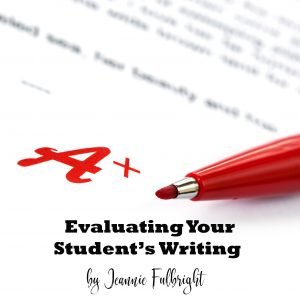Evaluating Your Student’s Writing
The following are the six evaluation guidelines. Your children can use these guidelines to evaluate their own writing, and you can use them to assign a grade to their writing. In order to turn this into a grade, assign a number from 1-5 to all the questions. Then add up the points for a grade.

1. Ideas and Content
The reason for writing should be clear. Every paragraph should support the overall theme or thesis. Keep a tight reign upon stray ideas and rabbit trails.
Evaluation:
The reason for writing is clear. 1 2 3 4 5
The writer made an effort to learn important details that support the topic. 1 2 3 4 5
The message is focused and maintained throughout the paper. 1 2 3 4 5
The reader understands what the writer is trying to communicate. 1 2 3 4 5
2. Organization
The structure of the paper should be well thought out, each paragraph having a clear focus with a proper opening and closing. The paper should begin well and conclude well.
Evaluation:
The thesis or theme is presented in an interesting or clear manner. 1 2 3 4 5
Each paragraph supports the thesis. 1 2 3 4 5
The focus of each paragraph is clear. 1 2 3 4 5
Every sentence is useful to communicate the thesis or theme. 1 2 3 4 5
The paper is easy to follow. 1 2 3 4 5
The paper concludes decisively. 1 2 3 4 5
3. Voice
Voice is what gives writing its flavor. Max Lucado and C.S. Lewis are great examples of people who have a specific voice in their writing. You can actually hear them talking when you read. Your child will develop her voice if she writes a great deal. Some writers have an authoritative voice, some a friendly familiar voice, some a friendly distant voice, and some a humorous or dry wit voice. Academic writing will have a professional third person voice.Many beginning writers inadvertently switch persons throughout their stories, essays, and narratives. It’s important they learn to maintain the same voice throughout the written work.
Evaluation:
The voice used is appropriate to the genre of writing. 1 2 3 4 5
The voice and person used are consistent. 1 2 3 4 5
4. Sentence Fluency
Using the same sentence structure over and over again leads to a monotonous paper. Varying the sentences and sentence patterns will make the paper easier to read. A sentence pattern is defined as the placement of the subject and verb, for example: The quick brown fox jumps over the fence. Over the fence, jumped the quick brown fox. Quick and brown was the fox that jumped over the fence.
Evaluation:
Sentences are clear and easy to read. 1 2 3 4 5
A variety of sentences (different beginnings, patterns, and lengths) is used. 1 2 3 4 5
5. Word Choice
Very young writers are encouraged to use a lot of adjectives and adverbs and other descriptive words in order to communicate the idea more accurately. As a writer matures, the use of adjectives and adverbs should be replaced with stronger verbs and more precise adjectives used less often. A strong vocabulary will enhance a student’s writing.It’s common for writers to repeat words over and over (enjoy, enjoyed, enjoying, enjoyable). A thesaurus should be used to correct this problem.
Evaluation:
Strong verbs are used. 1 2 3 4 5
Unique and interesting vocabulary words are used. 1 2 3 4 5
Words are not repeated. 1 2 3 4 5
6. Conventions
Conventions are spelling, punctuation, grammar, and paragraphing. Often, students struggle with paragraphing. They need to separate new ideas and thoughts with the paragraph. Each paragraph should conclude an idea and transition to the new idea. Proper use of conventions makes writing easy to read and follow.
Evaluation:
Grammar is used properly. 1 2 3 4 5
Spelling is on par with the child’s abilities. 1 2 3 4 5
Paragraphs are used correctly. 1 2 3 4 5
Extra Credit:
The beginning sentence or paragraph is a fascinating, attention grabbing hook for the reader. 1 2 3 4 5
The conclusion leaves the reader with a thought provoking question, a desire to act, or a valuable insight. 1 2 3 4 5
And there you have it. An easy and effective tool for evaluating your student's writing.
Read on for more help with teaching writing.


